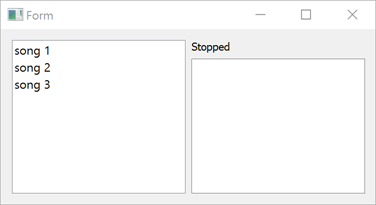Qt SCXML Media Player QML Example (Static)
A Qt Quick application that sends data to and receives it from a compiled ECMAScript data model.

Media Player QML Example (Static) demonstrates how to access data from an ECMAScript data model that is compiled into a C++ class.
The UI is created using Qt Quick.
Running the Example
To run the example from Qt Creator, open the Welcome mode and select the example from Examples. For more information, visit Building and Running an Example.
Using the ECMAScript Data Model
We specify the data model as a value of the datamodel attribute of the <scxml> element in mediaplayer-common/mediaplayer.scxml:
<scxml
xmlns="http://www.w3.org/2005/07/scxml"
version="1.0"
name="MediaPlayerStateMachine"
initial="stopped"
datamodel="ecmascript"
>
<datamodel>
<data id="media"/>
</datamodel>
Compiling the State Machine
We link against the Qt SCXML module by adding the following line to the .pro file:
QT += widgets scxml
We then specify the state machine to compile:
STATECHARTS = ../mediaplayer-common/mediaplayer.scxml
The Qt SCXML Compiler, qscxmlc, is run automatically to generate statemachine.h and statemachine.cpp, and to add them to the HEADERS and SOURCES variables for compilation.
Instantiating the State Machine
We instantiate the generated MediaPlayerStateMachine class in mediaplayer-qml-static.cpp:
#include "mediaplayer.h" int main(int argc, char *argv[]) { QGuiApplication app(argc, argv); qmlRegisterType<MediaPlayerStateMachine>("MediaPlayerStateMachine", 1, 0, "MediaPlayerStateMachine"); QQmlApplicationEngine engine; engine.load(QUrl(QStringLiteral("qrc:///mediaplayer-qml-static.qml"))); if (engine.rootObjects().isEmpty()) return -1; return app.exec(); }